ORDER
Pelecaniformes
FAMILY
Anhingidae
GENUS & SPECIES
KEY FEATURES
Llegant wateird i with S-shaped neck; basis for its alternative name, snake bird
• Often swims with only its head and neck above water surface
• Hunts for fish mostly in freshwater, catching its prey with a darting
movement of its head
• Breeding pairs are essentially monogamous and reuse their nest sites
WHERE IN THE WORLD?
Found in South America, from Uruguay and southern Brazil to Ecuador, Colombia and Panama; also north through Mexico to southeastern U.S.

Lifecycle
Nonrepellent feathers are a mixed blessing for the anhinga; they reduce its buoyancy, making it superb at fishing, but they must be dried quickly to stop it from catching a chill.
HABITAT
Unlike its marine relatives, the anhinga is usually found in freshwater habitats, perching on branches next to lakes, marshes and rivers. Brackish estuaries, mangrove swamps and shallow bays also play host to the anhinga. Wherever it lives, waterside vegetation is a standard feature and provides safe nesting and roosting sites.
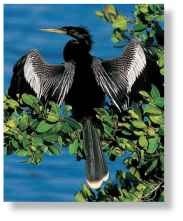
A Place in the sun The anhinga rests on nearby branches to dry its wings.

FOOD & HUNTING
Fish feature heavily but not exclusively in the anhinga’s diet. Across its range, it consumes various species, the majority being under 4″ in length and slow moving.The anhinga also preys on aquatic amphibians, reptiles, mollusks, leeches and crustaceans.
A typical hunting foray starts with a serene, splash-free dive under the water. The anhinga hunts in the shallows among aquatic vegetation. Although it often stalks its prey for a minute or more, it seldom gives chase for long and prefers to wait in ambush. It has a habit of spreading its wings when it hunts; the precise reason is unknown, but it may act as a lure, tempting fish to approach what appears to be a shady resting place.
As soon as a fish comes within range, the bird strikes. A hinge mechanism between its neck vertebrae and powerful neck muscles enables the anhinga to straighten its neck
Slipping down with lightning speed. Its victim A fish swallowed head secured, the anhinga comes to first is less likely to get the surface to eat its meal. stuck.
BEHAVIOR

The daily life of the anhinga is not a hectic one. In food-rich areas, the bird doesn’t invest all its time hunting. Instead, it spends most of the day sunning and preening itself in loose groups of fewer than 10 birds, but occasionally as many as 100. Nevertheless, the anhinga is not overtolerant of its own species and squabbles often occur at shared perches.
In the air, the anhinga has a graceful flight, alternating between flapping and gliding. Its long tail helps it maneuver deftly among the dense vegetation, and its broad wings enable it to soar to great heights on thermals (warm columns of rising air).
The anhinga has poor insulation against the cold, confining it to mostly tropical and subtropical latitudes.Those populations that breed at the northern limits of its range, most notably those in south-central U.S., desert their nesting grounds in October and fly to warmer wintering grounds in Mexico.
Dry-cleaning bill Successive dives ruffle the feathers of the anhinga, requiring the bird to spend much of its time preening.
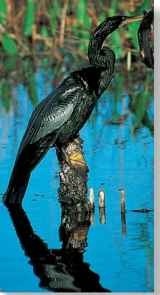
SPEAR FISHING
A Controlled diet The anhinga can take several minutes to manipulate and swallow a big fish.
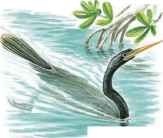
1 Having a break
In between dives, the anhinga cruises at a gentle speed with its body just below the water surface.
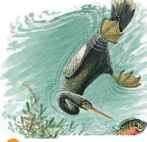
2 Taking aim
A fish swims by; the anhinga turns sharply and, using its webbed feet for propulsion, pursues its prey.
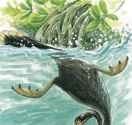
3 Back to work…
With barely a splash, the anhinga slips quietly under the water to resume hunting.
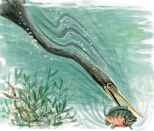
4 Breakthrough
In a split second, the bird strikes out and impales the fish on its lower mandible.
CONSERVATION
The anhinga is common throughout its range but is sensitive to habitat disturbance. Some local populations are threatened by activities such as draining wetlands and clearing waterside vegetation.The heavy use of pesticides in parts of the anhinga’s range also poses a threat. Even though its use was widely banned in the 1970s, the chemical DDT continues to contaminate and hamper the breeding success of the anhinga and other birds in the U.S.
Whenever the anhinga feels threatened, either while flying or perching, it plummets into the water, remaining submerged for as long as possible.
After breeding, the anhinga molts its flight feathers, and for a brief period is unable to fly.
The anhinga tolerates other birds and is often found in mixed breeding colonies with egrets, ibises and cormorants.
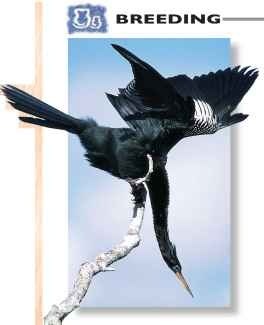
A Out to impress The male displays on a branch to attract a mate.
Breeding for many anhinga populations is a seasonal affair; even in those areas where the birds can nest all year-round, there is a “distinct peak.The anhinga is faithful to its partner forming a pairbond that may last several years.The pair often reuses a nest from the previous season; when not possible, it builds a nest from sticks and leaves among the reeds, bushes or overhanging branches.
The female lays a clutch of up to five pale-green eggs that are incubated by both parents for four weeks. The chicks hatch naked, but soon grow a coat of buff-colored down.The chicks develop fast and leave their parents after two months.
► Fresh start The nestling is not fully fledged until 6 weeks old.
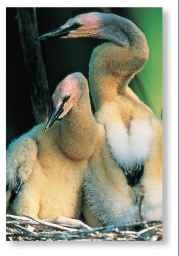
Profile
Anhinga
The anhinga seems a curious mixture of other birds, with the head, neck and wings of a heron, and the feet and plumage of a cormorant.
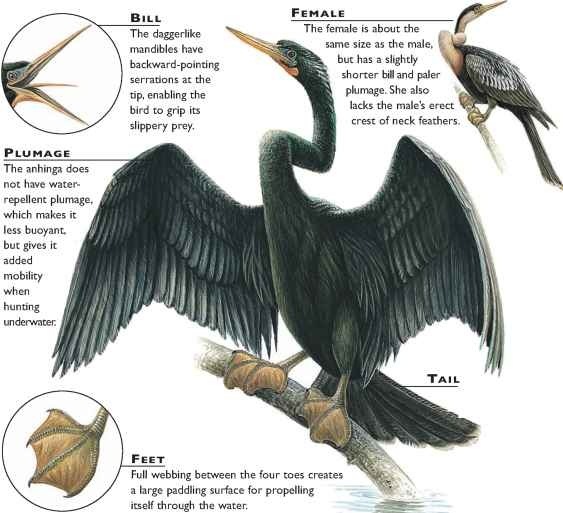
The anhinga uses its long tail to steer underwater.
CREATURE COMPARISONS
Across the Atlantic Ocean, the African darter (Anhinga rufa) has similar haunts and habits as the anhinga. Inhabiting inland waters across most of sub-Saharan Africa, the darter’s appearance differs from the anhinga only in detail. The African bird is slightly larger and has a distinctive, whitish stripe through each cheek. It lacks the crest found on the back of the anhinga’s head and has less silvery gray on its wings. Both birds perform aerial displays during courtship and breed in groups of several hundred strong.
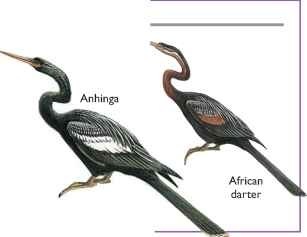
| VITAL | |
| STATISTICS | |
| Weight | 2.9-3.1 lbs. |
| Length | 32.5-36.5″ |
| WlNGSPAN | 4′ |
| Sexual i Maturity | 2 years |
| Breeding Season | Seasonal or all year, depending on region |
| Number of Eggs | 3-5 |
| Incubation . Period | 25-28 days |
| Fledging Period | About 42 days |
| Typical : Diet | Mainly fish, with a few amphibians, reptiles and invertebrates |
| Lifespan | At least 9 years |
RELATED SPECIES
• The anhinga belongs to Pelecaniformes,an order of fish-eating waterbirds that includes pelicans, gannets, egrets, ibises and cormorants. Its own family, Anhingidae, has 4 species, collectively known as the darters because of the way they spear fish. The other 3 species include the Asian darter, the African darter and the Australian darter; some classify these as a single species.

